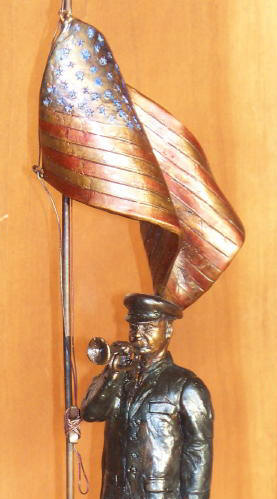by Pamela Harr
Pamela’s very personal gratitude and respect for members of the American Armed Forces is represented by these sculptures of soldiers playing Taps under an American flag flying at half mast.
One sculpture portrays the soldier in dress uniform, the other in his fatigues. Each sculpture is presented in two versions, one twelve inches tall, the other six inches tall.
TAPS 12-INCH VERSIONS


The 12-inch version is the model for life-size sculptures in the Northeastern Montana Veterans Memorial at Fort Peck, Montana. For information about the Memorial visit www.veteransmt.org.
The first casting has been installed in Harr Hall in Fort Moore (formerly Fort Benning) Army Base in Georgia to commemorate the 150 Year Celebration of the base’s origin during the Civil War.
The sculpture pictured is the bugler in fatigues; the same size version of the soldier in dress uniform is available to order. The soldiers are 12 inches tall; the flagpoles are 33 inches tall.
Each soldier, in dress uniform or fatigues, is of a limited Edition of 200.
$3,600 each
Taps-6 inc Versions
6” high
Limited Editions of 500
$995 each




The Origin of Taps
Before the advent of the field radio, the bugler was one of the most important members of a fighting force since orders for battlefield maneuvers were relayed by bugle calls. Taps, one of the most beautiful and haunting bugle melodies , is recognized throughout the world as most uniquely American.
Although there are several versions of the story of the origin of Taps, one favorite dates back to the Civil War when at the end of the Seven Days Battle at Harrison’s Landing near Richmond, Virginia, Union General Daniel Butterfield adapted Scott’s Tatou for “Return to Quarters” into the somber 24 notes that we recognize today as Taps. The notes are much longer and drawn out, and the bottom note was omitted. Taps was performed each evening as a signal for the troops to end the day and rest. The custom spread quickly throughout the Union Army and was even used by the Confederates.
The decision to use Taps in a military burial service arose out of necessity. Artillery company Captain John Tibbel planned a burial ceremony for one of his cannoneers. He was afraid that firing three volleys at the funeral would lead to the mistaken assumption that fighting had commenced. Instead, he ordered a bugler to play Taps. This was the first official record of Taps performed during a funeral.
After the Civil War, playing Taps was common in military funerals, but it wasn’t until 1891 that it was officially designated in the manuals as requisite. Air Force Master Sargent Jari Villanueva, former Arlington National Cemetery ceremonial bugler, sums up its significance. “ Its echoes linger in the heart long after its tones cease to vibrate in the air. The same can be said of those who made the ultimate sacrifice; their legacy lingers and their bravery is not forgotten.”
TAPS
Day is done. Gone the Sun
from the lake, from the hills, from the sky.
All is well. Safely rest. God is nigh.
The first casting of the bronze sculpture Taps-An American Soldier, by Pamela Harr, is in the Harr Hall display in Fort Moore (formerly Fort Benning), Georgia. It is a memorial to Captain Gerry Harr who was killed in action, on July 3rd 1971, while serving with C Company, 1st Battalion, 46th Infantry Regiment, during the Vietnam War.
Taps is sounded during each of the 2,500 military wreath ceremonies conducted at the Tomb of the Unknowns every year. Taps is also played nightly at 10 PM (2200 hours) in military installations at non-deployed locations to signal lights out. When Taps is played, it is customary to salute if in uniform, or to place the right hand over the heart if out of uniform. After Taps is played, it is disrespectful to clap.
For more information on the history of Taps, visit Music in History–Blowing Taps.


